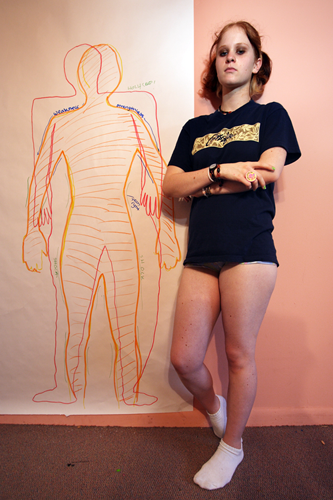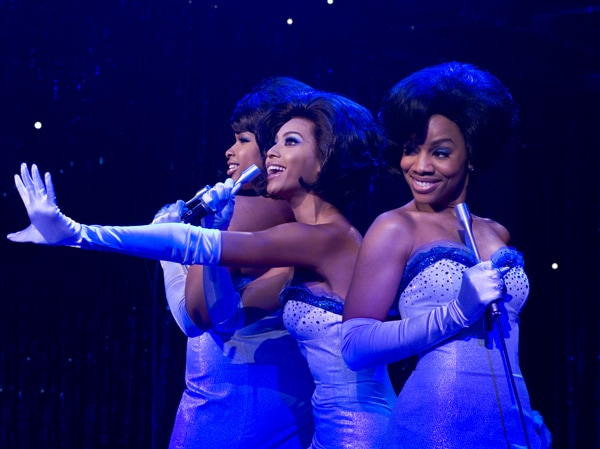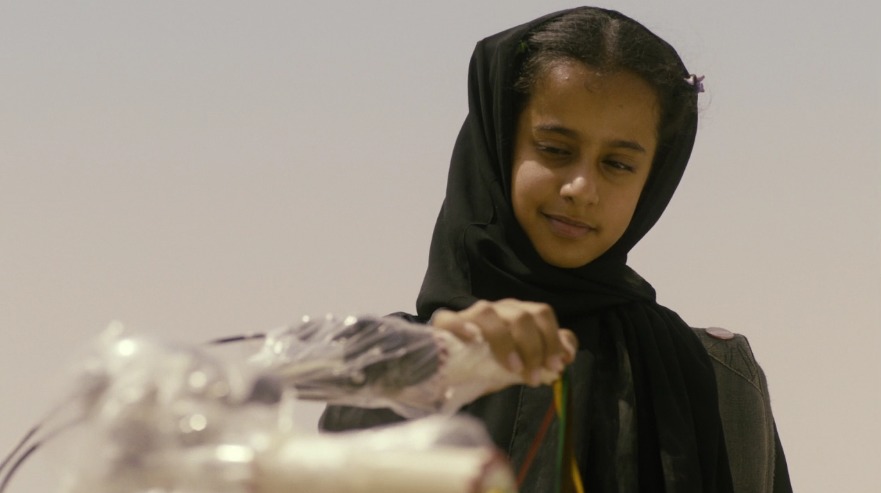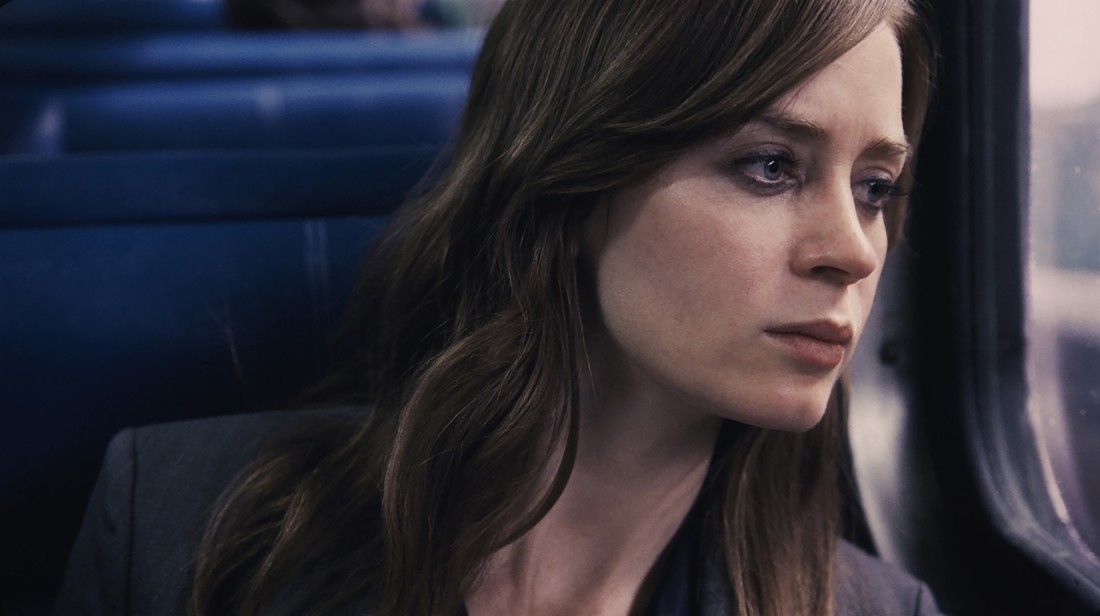|
For any other ancients who remember the oldies being the 40s, 50s and 60s, Dreamgirls is a fun reminder of a time gone by. Based on the Supremes it is a story of African Americans rise in the music industry beginning in the early 1960s. Effie, Lorrell and Deena are childhood friends who grew up in humble beginnings and are hoping to make it big from singing. They join a talent contest to bring the audience to a standing applause though they do not win first prize. Still, Curtis Taylor Jr., a producer notices them and offers for them to perform as back-up for James 'Thunder' Early.
Effie does not want to accept the offer as she views singing back-up to be a trap, and none of them have met Curtis before but he convinces them that if they want to proceed with their talents they need an overseer to look out for them. They agree and the girls go on tour in a bus across the U.S. Eventually James is dropped from the group because of a drug habit and raunchy behavior that clashes with the needs of the sales. The girls form The Dreams, and Curtis remains their manager. But like with any tight knit group issues become emotional when Curtis begins sleeping with Deena, who is the prettiest, while he had been a couple with Effie. Effie dramatically leaves The Dreams, and when she tries to return she finds she cannot. Her place has been taken. Effie spends all her money in a few years and ends up on assistance with her daughter, who is likely Curtis's child as well. James reunites with The Dreams, but eventually succumbs to a heroine overdose in a hotel room. Though he was married he had been seeing Lorrell for eight years and she is devastated by his loss. The Dreams carry on with ups and downs and changing style to the times, to give a final performance during the late 1970s. Though, the music is modernized from its original form the story holds true to what the music industry did for African Americans. If something sounds good to an audience they are going to buy the music no matter what color the person is who sings it. It opened up doors for African Americans to be viewed as career professionals and as leaders rather than being in servile positions behind the scenes. By Sarah Bahl From the opening shot of Ixcanul, 14-year-old Maria’s face is difficult to read. Her mother prepares her for her first meeting in preparation for her arranged marriage while Maria stares directly into the camera. Like the volcano that is the namesake for the film, Maria seems dormant but perhaps preparing to explode at any moment. Written and directed by Jayro Bustamante, Ixcanul is one of the few films produced in Guatemala and in the Kaqchikel language, as well as the country’s second Oscar entry for foreign film. Set in an indigenous Mayan community, Maria (María Mercedes Coroy) faces an unwanted arranged marriage to Ignacio, an older but better off man from the community. Maria’s world is constrained to her family, her village, and the visits to the nearby Volcano that is a sacred site. In an effort to take control of her own fate, Maria dreams of escaping to the United States with Pepe, a farmhand who plans to cross the border. As so often happens throughout the rest of the film, her plans lead to worse complications, leading one to wonder if it was ever possible for Maria to control her future. The most skillful aspect of Ixcanul is the film’s treatment of Maria and her mother, Juana. After sleeping with Pepe, Maria finds herself pregnant and Pepe has left for the United States without her. Her mother (María Telón) discovers the pregnancy, but rather than shunning her daughter, Juana tries her best to help with folk remedies and practices, but none work. This dynamic could easily spin into several tropes about virginity, the disenfranchisement or abuse of young girls, but instead Bustamente’s writing takes a slightly askew turn by presenting Maria’s pregnancy as a family issue, and specifically a mother and daughter issue. While Maria is the one pregnant, mother and daughter set out to try and resolve the consequences together. Yet when consequences grow worse and worse, the film still treats Maria with compassion by maintaining the focus on the fact that Maria is a girl faced with life altering situations that are unfair to ask of her. Like the snakes that overrun the farm, a multitude of threats emerge. With the discovery of her pregnancy, Maria’s family faces homelessness and unemployment. After a snake bite forces Maria and her family to rush to the hospital, the outside world suddenly looms large and more dangerous than the snake. In a plot point that shows abuses and inherent racism in government and society against indigenous people, confrontation with larger society becomes invasion not salvation. Maria’s life is saved, but she is robbed of her child and her former dreams that the lands beyond the volcano would somehow deliver her from her situation, a point punctuated in the final shot of the film. The events of the final third of the film show that even if Maria had made different choices, she would be returned to the same ending because of external forces beyond her control. Ixcanul is a skillfully crafted debut work that shows characters in their lives and how external forces have an impact. The scenes build upon each other, as if showing their daily lives unfold; scenes of Maria and her mother doing chores, bathing, cooking, and so on, create a lyrical pacing as the story unfolds. Bustamente’s guiding vision pays both homage to his early childhood and mixed heritage, in a story that is as important for other Guatemalans and the rest of the world to see. This is certainly a film worth watching for budding talents and for an intimate and close look at another part of the world that is not often shown. by Jessica Flores  What is an eating disorder? When does what probably began as healthy weight watching become so extreme it is a disorder? I remember asking a friend years ago, who had been hospitalized for anorexia, how it started. She said it began with less butter on the bread. Then it was less bread. Then it was no bread at all. What lies at the heart of the disorder is body image. A person's vision of who they want to be becomes so warped that in trying to achieve this vision they are destroying themselves and breaking the hearts of those who love them. Thin delves into the world of four young women from the ages of 15 to 32, who need extreme treatment for both anorexia and bulimia. There is Shelly, who is 25 and has a degree in nursing. Polly, 31 who graduated with an English Literature degree. Brittany who is 15 and Alisa, 30, who lost her friends and general activities to bulimia. All are checked into Renfrew, a strict and thorough clinic that begins with a gloved baggage check. The girls are not allowed to bring jackets or bags into the dining room so the staff will know they are eating their food and not stashing it. Shelly has been on a feeding tube for five years. She's been hospitalized multiple times. She's missed her birthday, Christmas and other holidays to being in a clinic or hospital. Polly celebrates her birthday at Renfrew and eats a cupcake delicately and watchfully. Later her eyes tear up because her throat burns so badly after eating the desert. She looks young for her 31 years despite her dieting addiction and her smoking habit. She and Shelly become friends. They gossip on the "smoke porch," where the rules are different. Calories can be spoken of on the smoke porch. Staff bashing is allowed and is frequently done. Brittany went from overweight to underweight by losing 88 pounds in a single year. She arrives at Renfrew with liver damage and noticeable hair loss. She will pull at her skin and cry about being fat. Alisa describes one episode with her disorder. She went to McDonald's then Burger King for breakfast items after buying donuts. She then goes to a supermarket and buys two half gallons of ice cream, whipped cream, pastries, peanut butter and marsh-mellows, She goes home and eats the donuts, the entire dozen of them, then both breakfasts. She purges. She begins on the peanut butter. After purging the entire contents of her recent buy at the grocery store she'd go out for lunch and it would begin again. After these episodes she'd be in the hospital from dehydration as often laxative and other diuretics would be used. When she wasn't binging and purging Alisa would try to keep her diet to under 200 calories a day. She takes notes on every item, including "two peanuts" and the calories in relation to them. All the women leave treatment looking much better. Alisa's skin is smoothed out and her eyes are less angry. Brittany is thinner but her skin is clear and her hair looks healthy. Polly's weight is in a healthy range for her height, though she is asked to leave for unruly behavior in a very strict environment. Shelly looks like a whole different girl, with clear skin and eyes. But within a couple years the first of the four girls falls victim to suicide. Polly succumbs at the age of 33. Brittany continues to restrict and dies after completion of the film to anorexia. Alisa attempts suicide with diuretics and returns to Renfrew but goes on to live her life. Shelly lost 17 pounds after check out and went through shock therapy. One out of every seven people suffering from anorexia will die from the disorder. It has been written that when a person becomes anorexic they will be this way for the rest of their life whether or not they eat fine and seem fully recovered. But this doesn't mean they can't live a full and good life. By Sarah Bahl Director Haifaa al-Mansour made her mark in world cinema by making the first motion picture to be completely filmed in Saudi Arabia and the first film to be directed by a Saudi woman. It is only fitting that her film Wadjda details why this feat alone is nothing short of extraordinary and does so through the daily life of a young girl. By honing in on the details, Mansour masterfully displays her craft by showing some national injustices on the smallest stage.
The Girl on the Train begins with an element of control. "My husband used to tell me I have an overactive imagination," says a blue eyed woman who marks an X on the condensation of a train window. It is a blanket statement in that it is something one would say to a small child who has too many imaginary friends. Her name is Rachel and she thinks " I can't help it. Haven't you ever been on a train and wondered about the lives of the people who live near the tracks?"
Rachel seems contemplative. And if one has not read about the film before viewing it, the viewer will find that soon enough, a natural and artful curiosity about human nature has somewhere along the way turned into an obsession. She says, "I'm not the girl, I used to be." This is not the statement of an independent businesswoman, despite her suit-jacket. It's the mindset of a girl, lost, isolated and confused. Rachel's favorite house is number 15 Beckett Road. In the young blond woman who lives there, Rachel sees the life she lost. The woman stands in a bathrobe and slippers on the balcony. Other times she is curled up next to her husband as they sit in front of a campfire. Rachel sits in a bar and draws the couple on her sketchpad as she has a martini. And in a house two doors down from 15 Becket Road is a woman happily holding a baby. This is Rachel's old home, that she had with her husband, Tom. One does start to wonder what she does all day. A woman with a baby boy sits next to her on the train and as Rachel coos at the child the woman sees a bottle of hard liquor in Rachel's bag. The stranger looks angry and uncomfortable for it. It becomes increasingly apparent that Rachel is drinking phenomenal amounts, particularly of hard liquor. Her voice has the constant slur of someone who always has alcohol in their system. She drinks at bars and from a water bottle. Whether in public or private she usually drinks alone. Megan is the woman who lives at number 15. She is a bit of a lost soul herself as she does not fit into the yoga crowd, and her marriage is already crumbling. Megan speaks of the various phases of her modern life, She has been a rebellious teenager, lover, gallery director, nanny and whore though not all in that order. She wants to start her entire life over again and does not seem to appreciate nor be particularly happy with anything she has. Rachel's version of "Megan" is far more romantic. There's a sense of modern American isolation to the entire film. There's no extended family looking out for the women, nor does anyone seem to know their neighbors in a friendly way. Megan's best friend is her shrink. Megan's husband, Scott wants a baby. And she says to her therapist that he thinks her current nanny job will make her want to get pregnant. Help her to settle down. But Megan wants nothing to do with babies. She has the job for other reasons. When Megan disappears, Rachel begins on a quest to understand what happened the last night Megan was seen. She can't remember exactly and the blackouts leave her with fragmented and confused memories. She does know she saw someone who looked like Megan in a tunnel. But when she wakes up with her articles and hair covered in blood she has no idea what occurred. When detectives get involved it is brought to the attention of Rachel's roommate that she doesn't have a job and hasn't for the past year. She takes the train to New York and back every day. Her roommate is suspicious that Rachel did not kill Megan and gives her a few weeks notice. The memories filter back and forth and it is a kaleidoscope of who is the abuser and who is the abused. Eventually it is found who did kill Megan. It culminates in a fight fire with fire means to an end. And Rachel begins a new life. By Sarah Bahl |
Archives
June 2017
Categories
All
|




 RSS Feed
RSS Feed